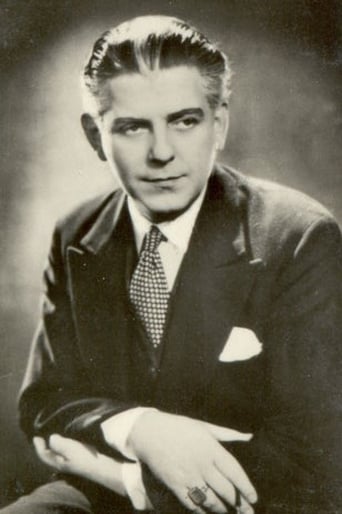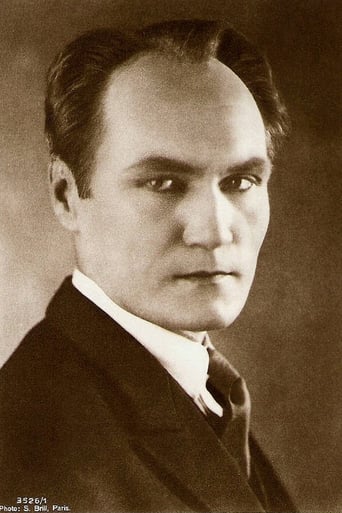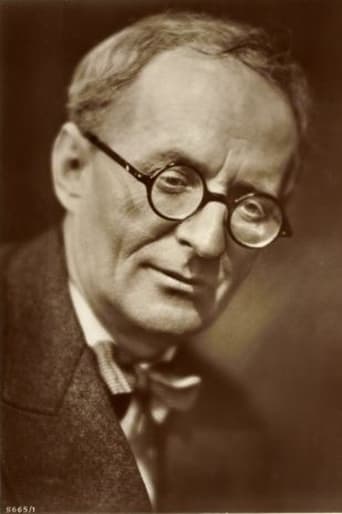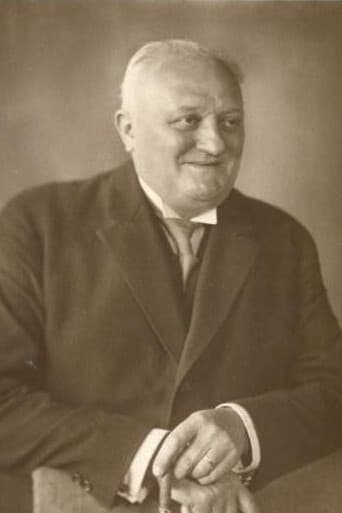Scanialara
You won't be disappointed!
FirstWitch
A movie that not only functions as a solid scarefest but a razor-sharp satire.
Fatma Suarez
The movie's neither hopeful in contrived ways, nor hopeless in different contrived ways. Somehow it manages to be wonderful
Cheryl
A clunky actioner with a handful of cool moments.
MisterWhiplash
In Destiny, everything with Death, a character who is one of the most striking and ominous figures in silent cinema (certainly from Germany which is saying a lot) as portrayed by Bernhard Goetze, and the woman (Lili Dagover, who I didn't realize until looking her up that she played other characters here) who is trying to save her man from Death's grasp in the opening 25 and closing 15 minutes, and how Death creates his gloomy but visually appealing enclave (all those candles and the space that's created, damn) which is closed off by a wall in town and how this woman goes through her own struggle to overcome him, is outstanding. The three "Stories" for the three candles - each representing someone that will die unless she does something to stop them, thus saving her man's life - not so much.Never is the direction ever poor or lacking, but I wasn't engaged in those stories how I was hoping for. They're all relatively brief, and while clearly Lang's aim is to make this a sort of fable or series of myths (remember he also did the Nibelungen films), you have little time to invest in any of these characters - all that's there is to find them, all of the people in worlds of royalty whether it's in the middle east, Europe or Asia, kind of interesting to look at. I can definitely see why this inspired Bunuel to become a filmmaker, but compared to work like Dr. Mabuse and Metropolis, it doesn't hold up quite as well (needless to say I'm sure it would still hold up over like a thousand other silent films, it's just a personal preference with regard to Lang's silent features).And yeah, as others have noted, it's kinda racist with the imagery in these stories, though mostly with the Asian 'Verse' section. In a way that doesn't bother me so much as it is Lang's preference for style over substance. Again, when the style is so intense and spectacular at times - all those dissolves and moments, like the carpet "flying up" into the air - it may be hard to complain. I think the expectation for practically all of Lang's films to be masterpieces may have worked against me in loving it, but suffice to say if you're looking for only the visuals you'll certainly get a lot out of it, and those first, second and sixth verses are potent. If the whole film had been involved with the young woman, young man and Death in the town, I would've loved it.
Hitchcockyan
Fritz Lang's DESTINY is an expressionistic romantic-fantasy that centers on a young 19th-century woman as she challenges "Death" in the hope of bringing back her prematurely taken lover. What follows are three moral parables - set in Persia, exotic Venice, and Imperial China, each dealing with ill-fated love. The multi-story format affords Lang limitless opportunities to exercise his cinematic chops. The sets are as usual breathtaking from Gothic cathedrals to eerie sky-scraping walls to oriental castles to never-ending staircases. There's some stunning imagery on view like a spectral horde disappearing into a wall at midnight and of a terrifying hour-glass vision, forecasting impending doom. Candles are used to great effect both aesthetically (to complement the surreal setting) and thematically (as an allegory for mortal life-spans). Bernhard Goetzke's mysterious, darkly-clothed, succinct embodiment of Death might seem stereotypical but is far from it. For Death is not depicted as an arrogant, mustache-twirling entity which revels in its limitless power or earthly dominance but contrarily has grown tired of it. Death has become weary of its inevitability, its invincibility and is compassionate towards his mortal subjects. I particularly enjoyed the newly composed score by Cornelius Schwehr and thought it blended seamlessly with the film's grim premise.DESTINY is perhaps most famous for igniting Luis Buñuel's surrealistic flames and leaving an indelible impression on an aspiring Hitchcock but to be honest the influences are unquantifiable. From its unmissable Bergman (and consequent Woody Allen) impact (THE SEVENTH SEAL and WILD STRAWBERRIES to some extent) to P&P's A MATTER OF LIFE AND DEATH. The multi- scenario life-saving premise was also reminiscent of Tom Tykwer's RUN, LOLA, RUN.In the end DESTINY proves to be an ambitious little early-Lang which is frequently thrilling but doesn't come close to some of his subsequent masterpieces, then again few things do.
Johan Louwet
OK Metropolis was very impressive visually for its time. However considering story and message this movie really isn't inferior. And when we are talking about visuals and special effects this film still stands strong in my opinion. I think it's more impressive in any aspect than Nosferatu. It was nice to see the sweetheart from The Cabinet of Dr. Caligari, Lil Dagover here as the protagonist. A lady trying to save her husband from death it's definitely something different and more original than what we are used to (usually it's the man trying to save the woman). She plays her role excellent just like Bernhard Goetzke as The Death who appears mysterious and cold-hearted. However both characters become more and more sympathetic and not as selfish any more as the story advances. Midway the movie drags a bit when the girl gets 3 chances from the Death and we have 3 different stories with the protagonists from the story in different roles. Except for the second story they are enjoyable. Especially the third story is nice with the special effects. However how we get to see the interaction between the living and dead (ghosts) is really well done. I really loved the decision the girl eventually makes, deciding not to destroy someone else's life to be reunited with her beloved. Touching story with a lovely message.
wmorrow59
The biographical entry for Fritz Lang in the invaluable World Film Directors reference book offers a revealing quote. It seems that when he was a teenager he became gravely ill, and at the peak of his delirium experienced a vivid hallucination. As Lang later described it, "I saw myself face to face, not terrifying, but unmistakable, with Death . . . I don't know whether I should call the feeling I experienced at that moment one of fear. It was horror, but not panic. I recovered quickly, but the love of death, compounded of horror and affection . . . stayed with me and became a part of my films." Lang, who was Austrian, served in the Army during the First World War where he saw considerable combat and, of course, encountered death on a horrific scale. (He also lost the use of his right eye.) While still in the service he launched his career in the movies by submitting screenplays to producer Joe May, and soon afterward acted in two of May's films, playing the Angel of Death in "Hilde Warren und der Tod." Lang began directing in 1919 and was successful almost immediately but remained largely unknown outside Germany until his first genuinely personal project, "Der Müde Tod," burst upon the scene in 1921 and became an international sensation. Lang's timing was perfect, for in the troubled period following the war interest in spiritualism and the afterlife was intense. This film represented the director's most thorough exploration of the fever dream of his adolescence, for here Lang utilized elements gathered from the myth and folkloric traditions of various cultures to explore a question posed by the leading lady to the Grim Reaper himself: Is Love stronger than Death?In the opening scenes we're introduced to a happy young couple who intend to marry. On their travels they encounter a stranger, a gaunt and unsmiling figure in a black cloak who is heading for the same village that is their destination; the very sight of him darkens the atmosphere and kills their joyous mood. The stranger is Death himself, who seeks to purchase land owned by the village elders. The stranger informs the elders that he is weary-- from his exertions during the Great War? --and wishes to settle down. Once he buys land the stranger erects an estate surrounded by an impossibly high wall, a wall with no apparent door or entryway, and his next act is to claim the soul of the Young Man. The Young Woman searches the village and fails to find her fiancé, but when she takes poison she is able to pass through the wall and confront Death. He takes her to a room filled with candles representing the souls of humanity. When the Young Woman demands that Death restore her fiancé to life he agrees to do so only if she can defeat him, and he gives her three opportunities.The Young Woman's three chances to defeat Death unfold in the form of three tales set in disparate parts of the world in three different historical periods: Persia in the days of the Caliphate, Renaissance Venice, and Imperial China. Three incarnations of her Young Man are threatened with extinction, and three incarnations of the Young Woman have a chance to rescue him. These stories make up the bulk of the movie and each is longer and more elaborate than the one preceding. Eventually, when the Young Woman proves unable to beat Death she is given one final chance to win back her fiancé, but when she finds the price demanded of her too high to pay, the lovers are nonetheless reunited in the afterlife in a strangely gratifying finale.The historical adventures take place in highly stylized worlds, especially the Chinese segment, but even the film's Middle-European framing story features expressionistic structures that resemble stage sets, just as the (unnamed) young man and woman at the center of these events are meant to embody folkloric archetypes rather than dimensional characters. Lang's Persia, Venice and China suggest a child's notion of what these places might be like; the palaces have the look of enormous doll-houses. And of course the magical element is derived from fairy tales: the Chinese magician summons a miniature army of soldiers to amuse the Emperor, and is himself later turned into a cactus (one of the film's most memorable and disturbing images), while the Emperor is a fairy tale villain with grotesquely long claw-like fingernails. "Der Müde Tod" is, with Maurice Tourneur's 1918 classic "The Blue Bird," one of the cinema's first great flights of fantasy, suffused with imaginative effects and whimsical touches but undergirded with a deep sense of sadness.Like many silent films this one has been shown in a variety of editions over the years, but the restoration completed in 2000 that is now available on DVD from Image Entertainment appears to be the closest to Lang's original version. This edition recreates the color tints of 1921 and the type-faces of the original title cards, which attempted to capture the exotic calligraphic styles of the three foreign lands of the adventure stories. (My only criticism is that I found the "Persian" type rather difficult to read.) This disc also boasts a beautiful score by the Mont Alto Motion Picture Orchestra, music that enhances the visuals without drawing undue attention to itself. For those who can't attend a public screening of this rarely shown gem the Image DVD is about as good as silent movies get on the home screen; and Fritz Lang's "Der Müde Tod" is one of the most fascinating silent movies.







